
Gardeners are always on the search for a few fast-growing plants to add to their vegetable patch. Those which germinate easily and are quick to harvest.
Why?
Simply because we get hungry and peckish while other crops take months and months to mature.
Plus, it’s an all-around fantastic feeling to head out to the garden and pluck a few fresh leaves to garnish your bacon and eggs. As if you went out to a posh restaurant.
It’s true, arugula is a trendy leaf that has only come into the picture in recent years. Yet, I wholeheartedly believe it is more than just a fad (like that thing with kale). With the right temperature and the absence of a few peckish pests, a bunch of arugula can be yours for the taking.
Ready to grow your own arugula yet?
Reasons to Grow Arugula
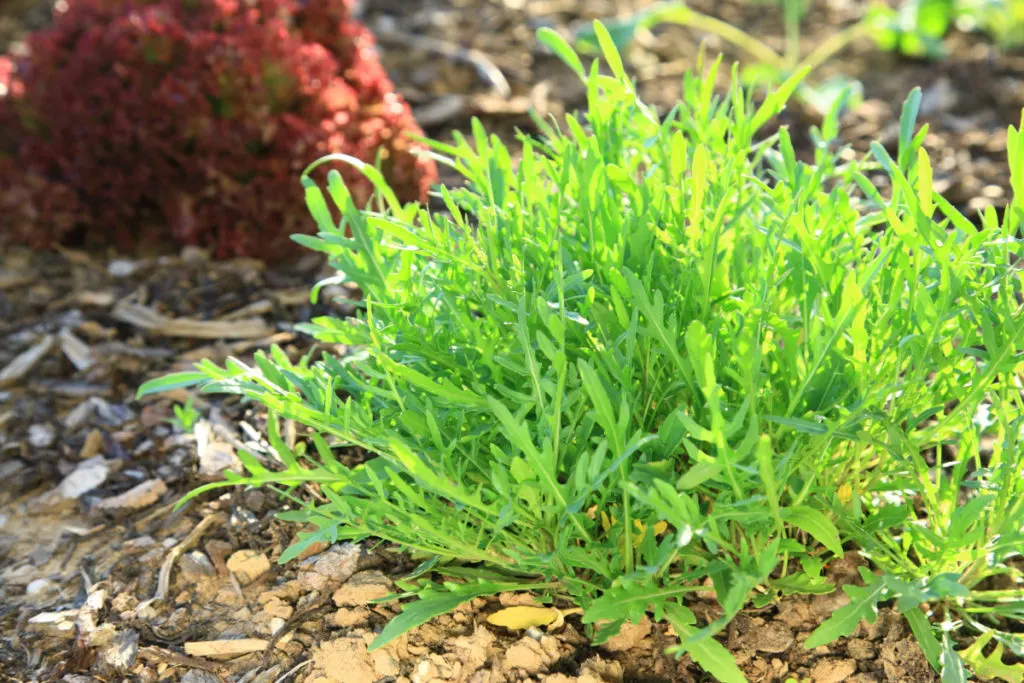
Eruca vesicaria ssp. sativa: rocket, garden rocket, rocket salad, roka, roquette, ruchetta, rugula, rucola. Give it whatever name you like. Just be sure to plant some in your garden and introduce it into your life.
For starters, arugula is a cool-season crop that is ready to harvest in about 40 days after seeding. How’s that for a quick harvest?
It also happens to be a member of the Brassicaceae family.
Next up is flavor.
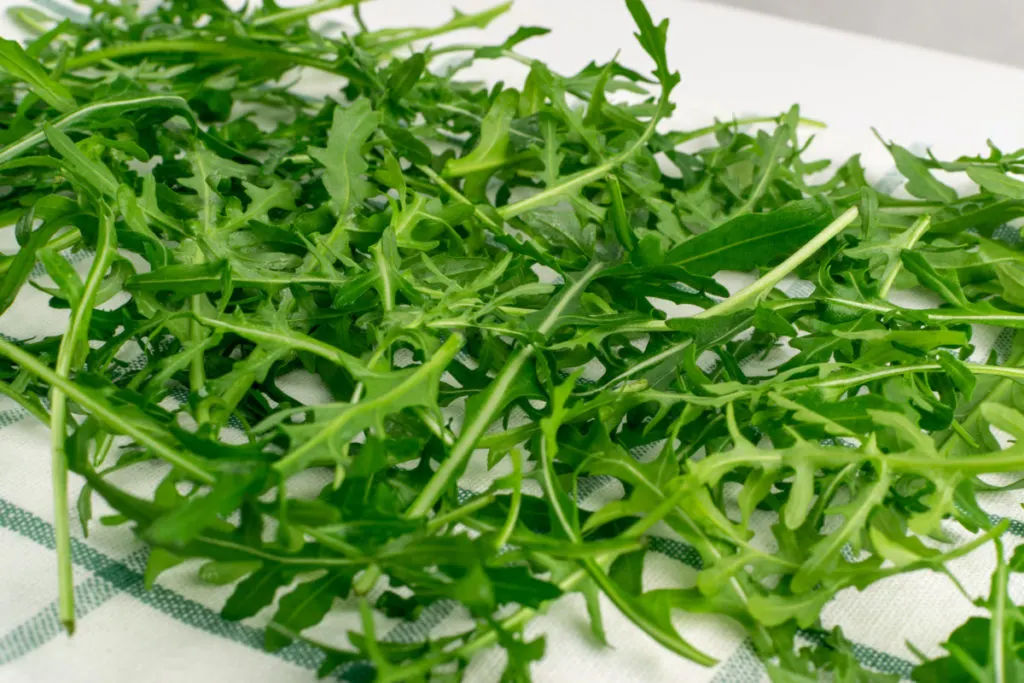
The peppery sharpness of each leaf is a beautiful thing. That is if you enjoy foods that pack a slight punch.
Arugula is an annual, though if you let it mature, it will drop its seeds on the ground. The seeds will germinate the following growing season when temperatures are just right.
This makes arugula a self-sufficient vegetable in your garden. Tending to it is uncomplicated, as it does much of the work for you. Although you may need to go in and weed a little.
Arugula is also notable for its vitamin and mineral content, even exceeding spinach and kale in some instances.
It can be planted in full sun, yet it also tolerates partial shade.
Plant it directly in the ground or in containers, so long as the soil is well-draining. The only time arugula is difficult to grow, is in the heat of summer.
Spring and fall are the best times to plant and harvest arugula for both their leaves and edible flowers.
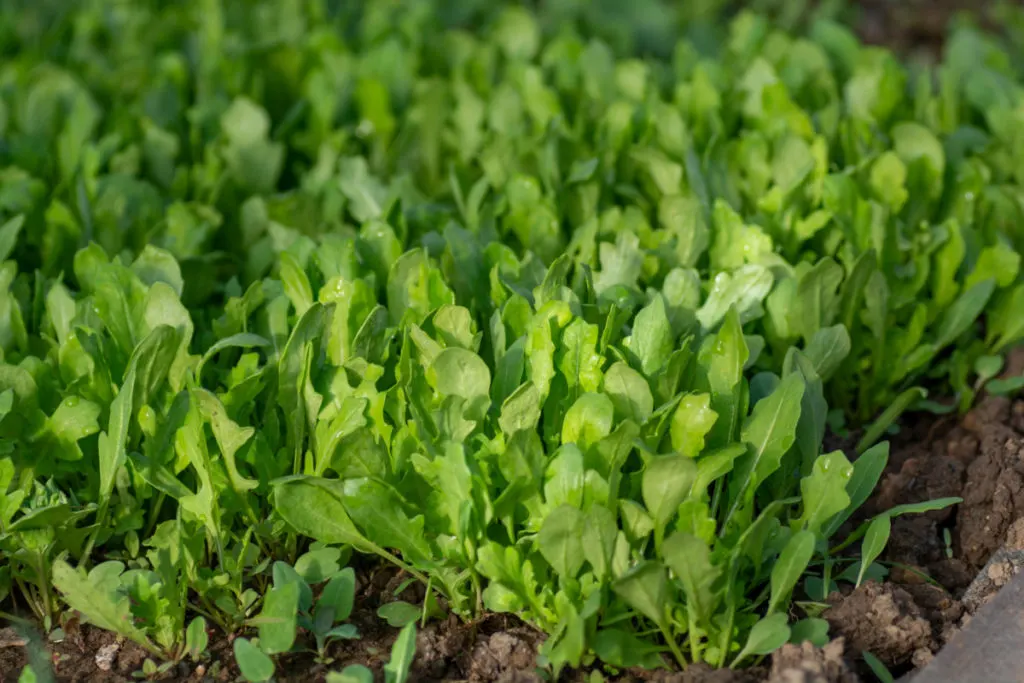
How to Plant Arugula
First things first, you’ll have to select a tasty variety of arugula before planting.
Look for these varieties of arugula where seeds are sold:
In many cases, baby greens are ready to eat in only 21 days.
On to planting…
Arugula seeds can be direct-sown from the moment the soil can be worked outdoors. It can also be late-summer or fall planted – just be sure to keep into account your first frost date when sowing seeds.
The seeds will germinate in soil temperatures down to 40°F (4°C), making it one of the first seeds to sow in the garden.
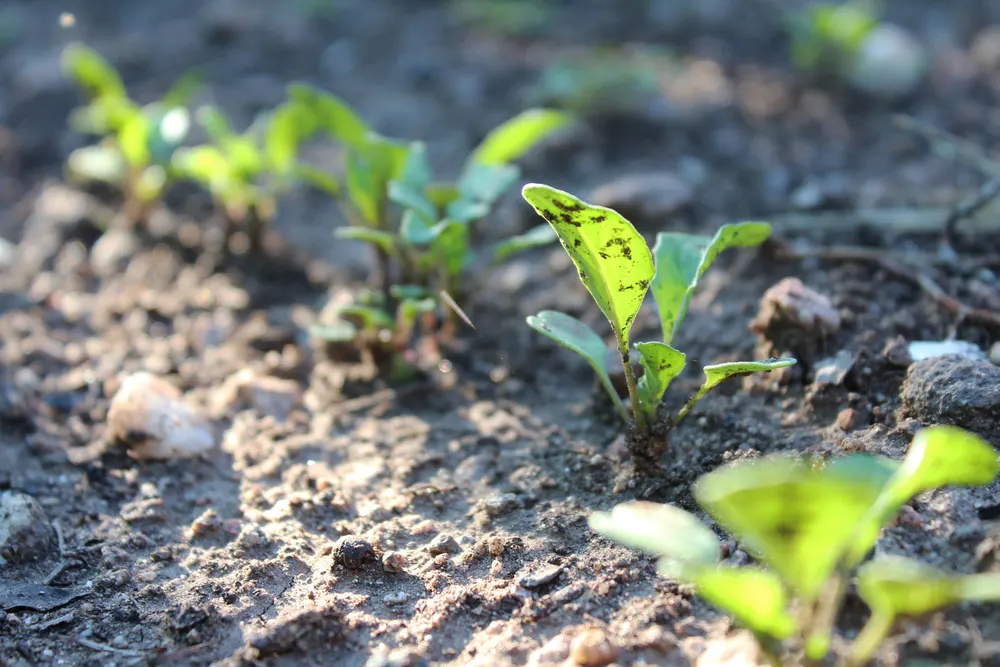
Related reading: 15 Vegetable Seeds to Sow Outside Before the Last Spring Frost
To sow arugula seeds, set them in the ground not more than 1/4-inch deep. In general, they should be planted about 6″ apart. However, if you sow the seeds more densely, you can then thin the plants to this measurement.
Be sure to eat the plants you thin out.
Rows of arugula should be about 10″ apart.
Arugula plant habits
When mature, individual arugula plants can reach a modest height of 10-24″.
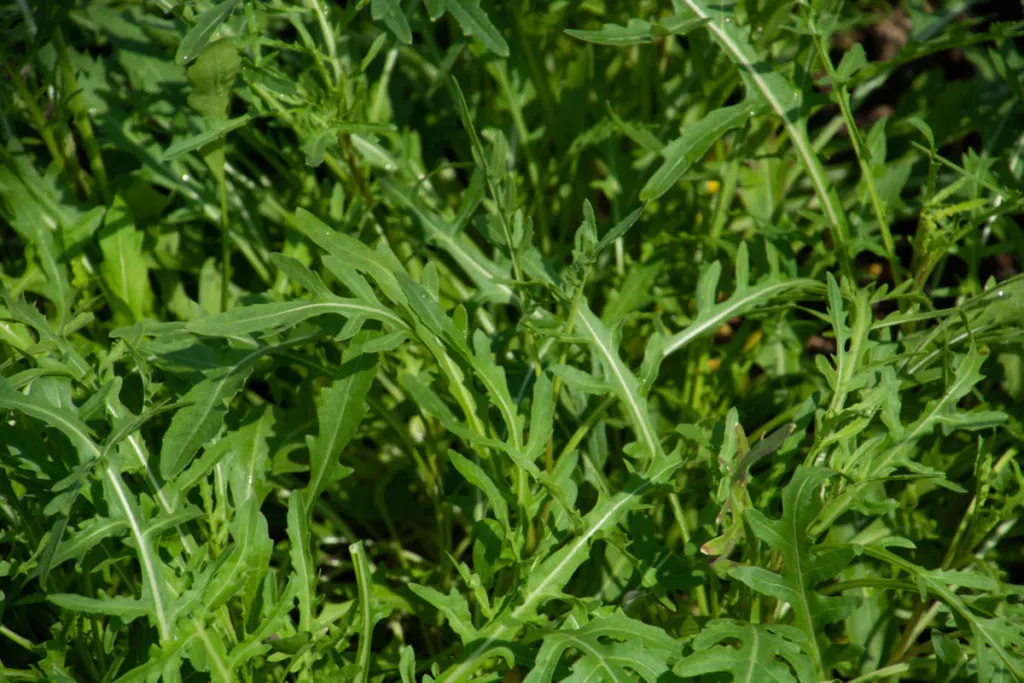
The leaves are irregular and pinnately-lobed which appear in rosettes. In some cases, they resemble a feather and often look like some elongated oak leaves.
Their mustard-like flavor comes in handy in the kitchen, as you’ll discover in the versatile recipes below.
Sow arugula seeds every 14-21 days as cool weather persists for a continuous harvest.
For the most part, arugula will grow in nearly every type of soil. Though it performs the absolute best when it has access to plenty of organic matter.
Flavor-wise it is the most pleasantly peppery when it isn’t stressed by either drought or excess heat.
Can I grow arugula in a container?
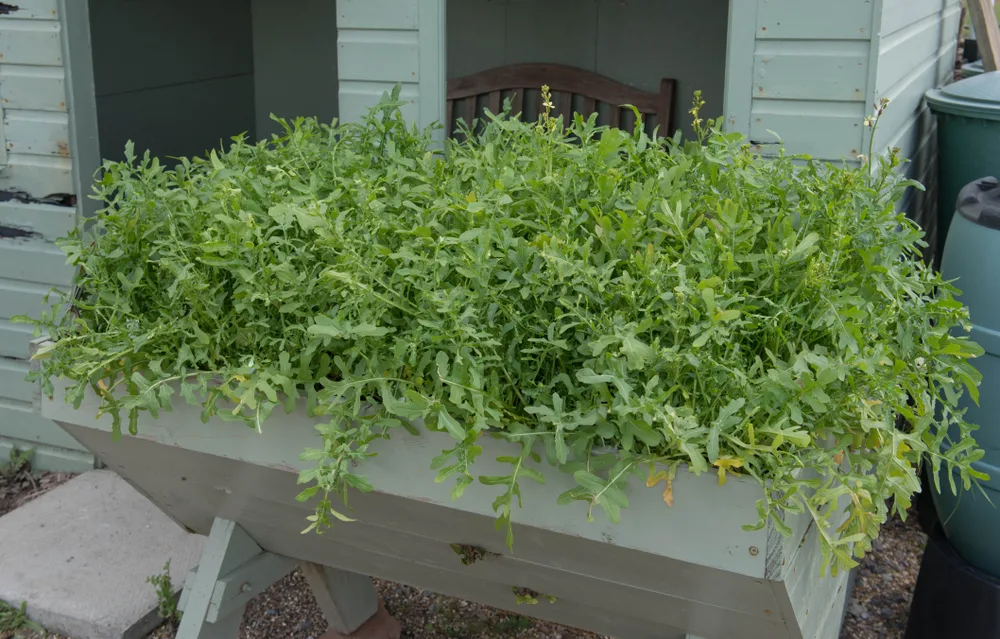
Yes, you absolutely can. Arugula makes a wonderful addition to your container garden.
It also grows well in raised beds too.
The most important thing to know about growing arugula is that the soil should be kept evenly moist. Not too dry and definitely not soaked. This will help prevent arugula from bolting in warmer weather.
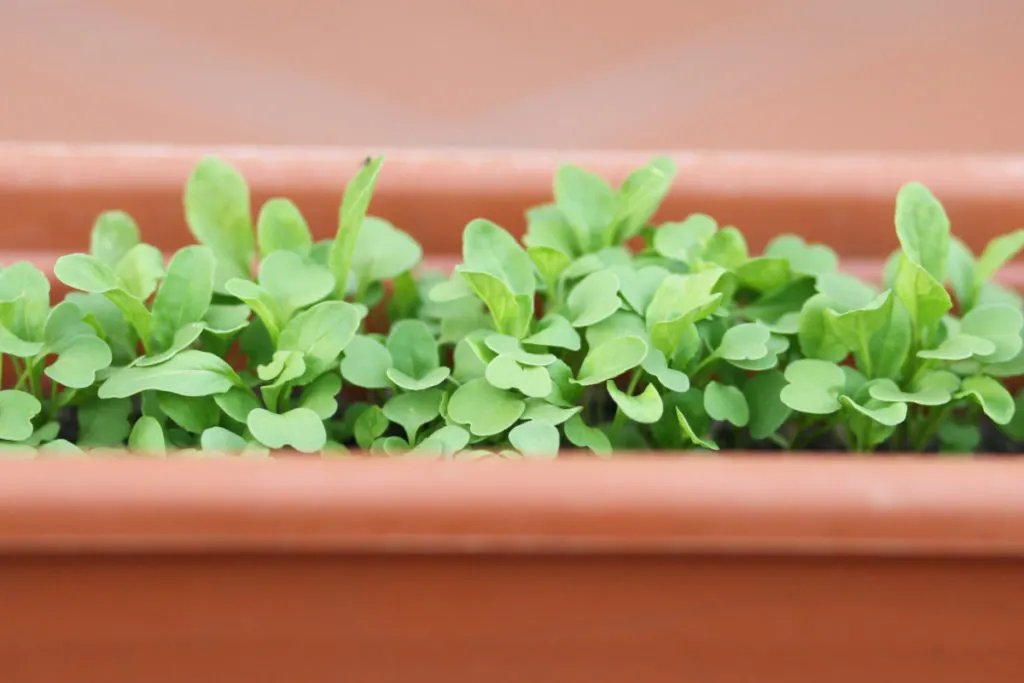
As the summer sun begins to shine, arugula leaves turn bitter and less palatable. So, be sure to eat the leaves when they are young and tender.
When the arugula flowers arrive, start eating them as well. Unless you are intent on saving seeds. You’ll only need to set aside a couple of plants for that purpose.
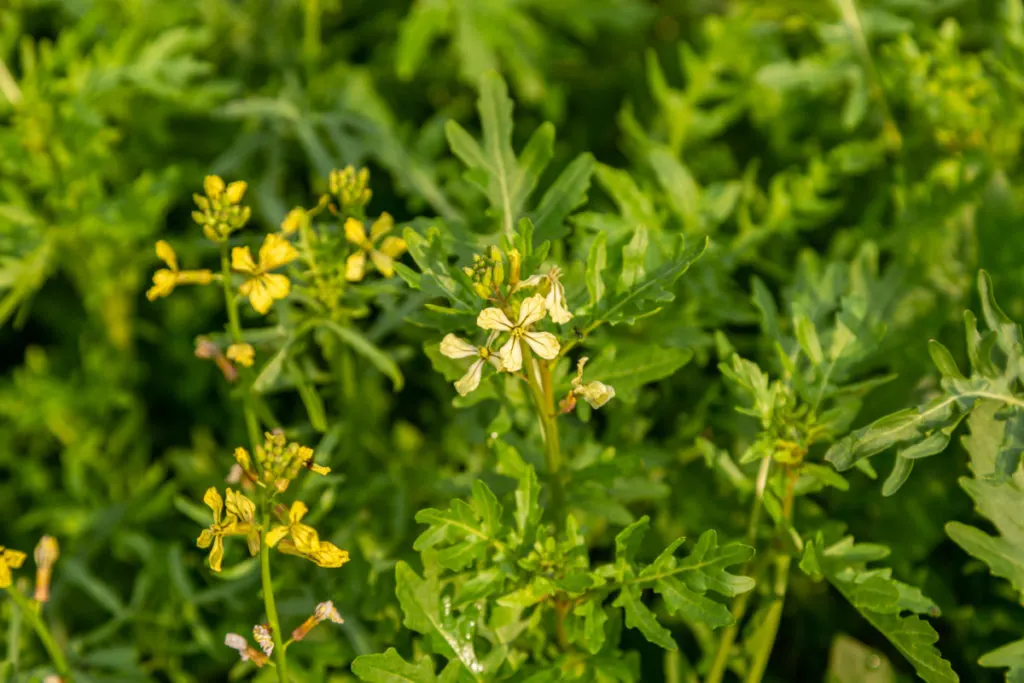
Companion Plants for Arugula
What should you plant next to your arugula for the best chance of survival?
We’ll mention a few problems with growing arugula down below, but for now, all you need to see are flea beetles. I don’t know what it is that they love about arugula, though they can make a plant quite lacy in a matter of days.
If you are new to the arena of companion planting, it’s all about finding out what plants make good neighbors or bad ones. There are quite a few incompatible plants out there, let’s highlight the good ones to plant with arugula.
Herbs and flowers for companion planting with arugula
- borage
- chamomile
- chives
- coriander
- dill
- mint
- nasturtium
- oregano
- parsley
- sage
- thyme
Companion vegetables for arugula
- beets
- bush beans
- carrots
- celery
- corn
- garlic
- onions
Keep in mind to avoid planting arugula where the previous year’s cabbage family has been, as it will attract similar pests.
While companion planting won’t keep all diseases and challenges away, it will limit them. It is definitely worth a try, especially if you want abundant green harvests.
Harvesting Arugula
Arugula is best consumed fresh from the garden within minutes of gathering.
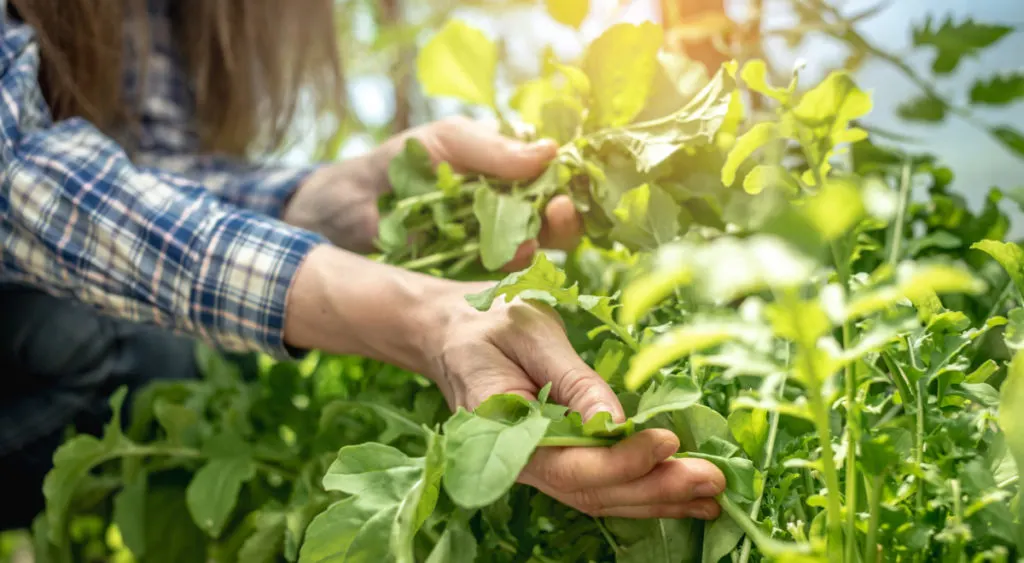
You’ll find some tasty recipes below, but for now, how will you know when it is ready to harvest?
How long till the first arugula harvest?
As mentioned, the days to maturity for arugula is approximately 40 days.
But, you don’t have to wait that long to pluck a few leaves here and there.
Just 3 weeks (or when the leaves are 3″ long) after planting you can start harvesting baby leaves for salads and sandwiches.
The youngest leaves will be tender and less pungent. As they mature, the peppery flavor will really stand out. At that point, they are best for cooking.
How many times can you harvest arugula?
The truth is, it is best to harvest a few leaves of arugula at a time. Some from each plant and not all at once. Then let them rest and regenerate.
In this way, you can eat arugula throughout the cooler months.
To extend the growing season into the heat of summer, it may be beneficial to provide them with a shade cloth. Or simply plant them in the shade of taller plants, such as beans, tomatoes or corn.
Should I let my arugula flower and/or go to seed?
Once your arugula begins to flower, it signifies the descent of its growing season.
But, it isn’t over yet.
You still have a chance to eat the flowers. And there will be many of them. You might even find that you prefer the arugula flowers over the leaves. Perfectly normal.
They look beautiful in salads, plus they taste amazing too.
If you don’t eat all the flowers, you can also save seeds.
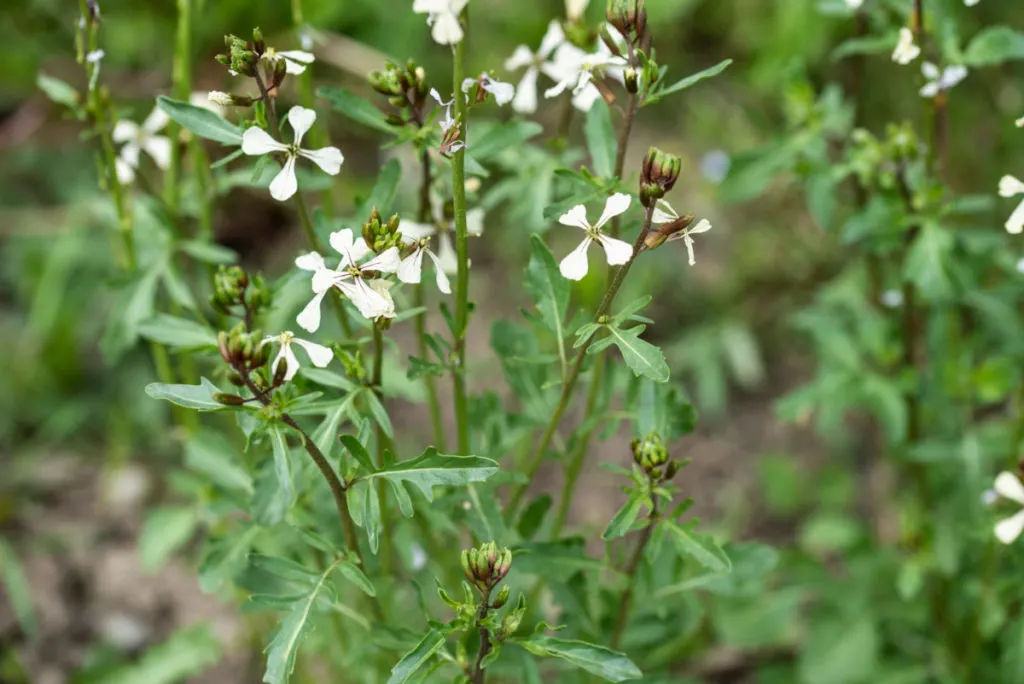
You’ll be amazed at all the insects that come to the arugula flowers. That’s a wonderful thing, especially if you want to save your own seeds.
Once the seed heads have matured, the entire plant can be cut and hung upside down to finish the drying. Make sure to do this undercover, so it isn’t rained on.
The arugula seeds are dry enough when they are difficult to dent with a fingernail.
Thresh them by hand between layers of cloth, to gently break off the dry pods. They can be cleaned further with the use of a screen or fine-mesh strainer. Now they are ready for labeling and storing until the next planting time comes around.
Potential Problems Growing Arugula
Remember the flea beetles from above?
Really they come from below. Flea beetle larvae hatch from eggs and immediately begin feeding on the roots of newly planted seedlings.
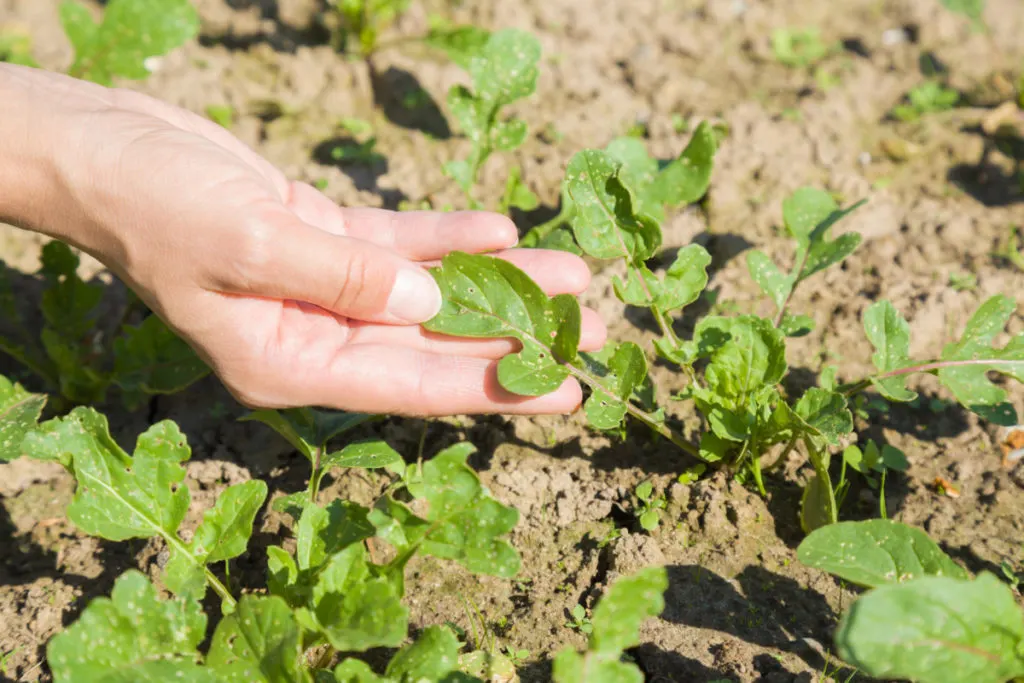
What a nuisance they can be. They jump (hence the name flea) and they devour several garden crops. This includes young Brassicas, radishes, squashes, beans, corn, potatoes and lettuce.
Flea beetles also have an appetite for weeds.
How to get rid of flea beetles?
Total eradication of flea beetles is usually not achievable. Don’t search for perfection here.
What you can do is limit their numbers, giving your plants a good chance at survival.
Luckily, there are several non-chemical methods that are effective in reducing their presence:
- homemade insecticidal soap made with liquid Castile soap
- diatomaceous earth
- neem oil solution
- beneficial nematodes
- or sticky traps as a last resort
Otherwise, go back and review the companion planting section for some non-invasive gardening methods.
Arugula can also be affected by leaf miners, aphids, slugs and snails.
Eating Arugula
Arugula is a fantastic green, for it can be tossed into all manner of home-cooked meals.
It can be added in varying amounts to salads, egg dishes (omelettes, poached eggs, scrambles, etc.), quiche, soups, breads, sandwiches or as a peppery pizza topping.

Best of all, when you pick it from the garden you know it is one hundred percent fresh. Without plastic packaging or slimy leaves. If you’ve ever purchased it from the store, you’ll know what I mean about the latter.
Arugula nutrients
Naturally, arugula is a low-carb vegetable, coming in at less than 1 gram per serving. While that is a positive thing, remember that it is great to regularly get your fill of organic greens anyway. Best of all when you grow them at home.
Not only is arugula rich in antioxidants, it also contains:
- calcium
- iron
- vitamins A, C and K
- folate
- potassium
- magnesium
It has the ability to improve your overall eye health, it supports your amazing immune system and it’s great for bone health.
What’s not to love about a vivacious green you can easily grow in your windowsill garden?
Recipes using arugula
Now you know how and where to sow the seeds and when to harvest them.
How about serving arugula in more creative ways than as a garnish?
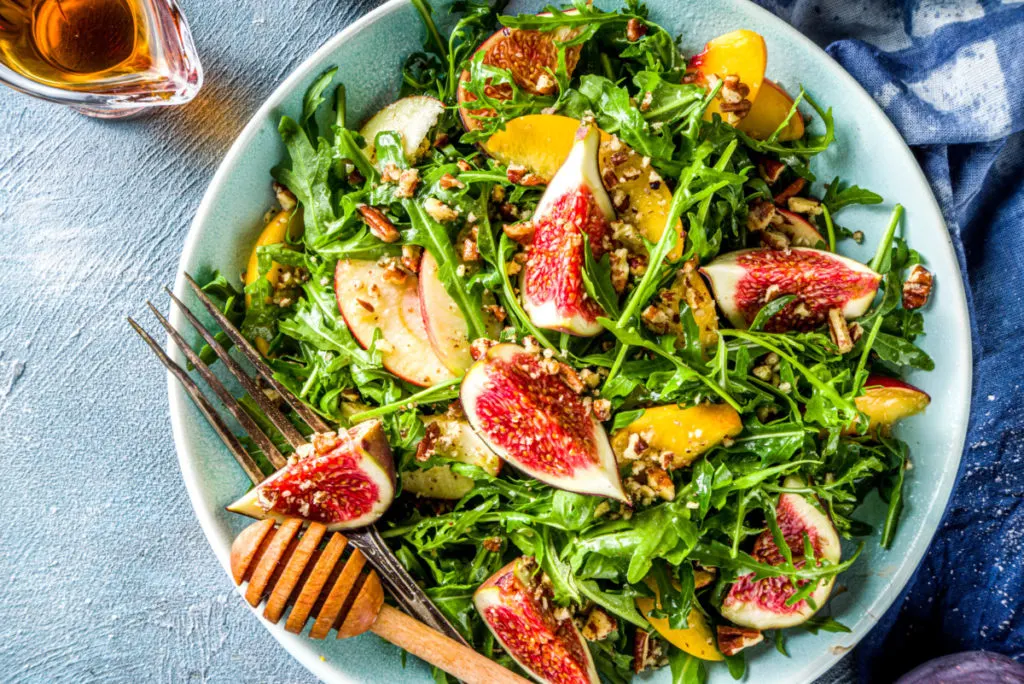
Start with a few of these recipes, then grab a bunch more leaves and create your own.
- baby arugula and blood orange salad
- roasted beet salad with goat cheese, pistachios and arugula
- arugula and watercress salad with orange-poppy dressing
- fettuccine with corn, leeks and arugula
- arugula pesto
- mushroom and arugula pizza
- arugula and avocado spring salad
- bacon and arugula quiche
Play it down, scale it up, bake some arugula-cheese tarts and call it a well-deserved harvest.
Or take a shopping trip to the market or store, should it not be growing in your garden at this time.
Growing Arugula as Microgreens
Arugula isn’t a finicky vegetable. It will grow equally well inside, if not better than direct sown outside in the soil.
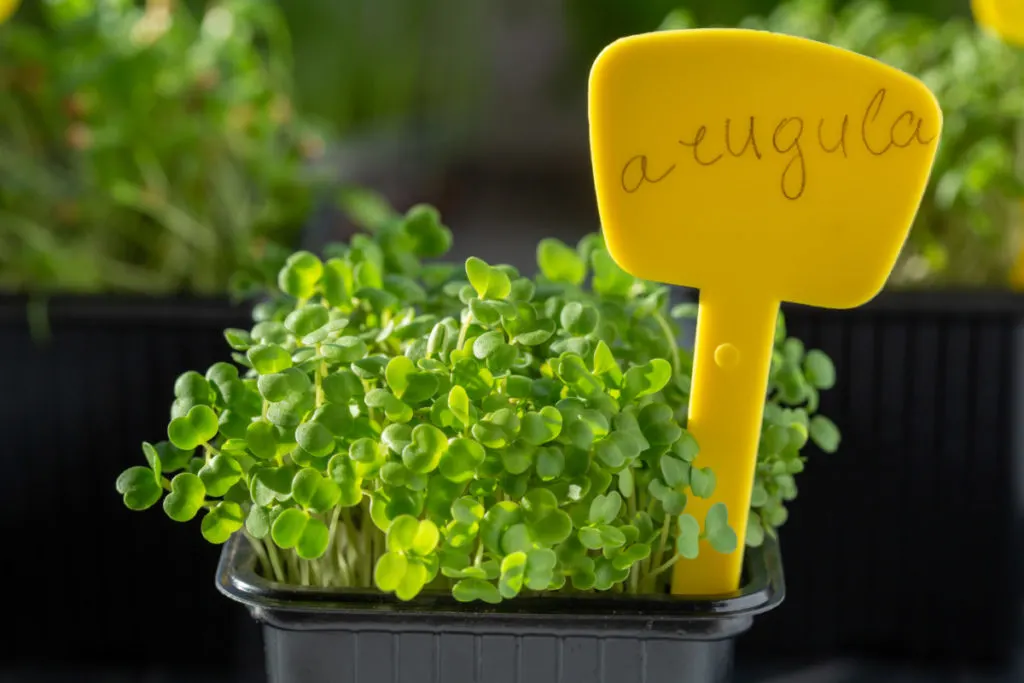
In that case, however, it makes perfect sense to grow them as sprouts or microgreens. It’s fast, it’s easy and you can have your first harvest in as soon as 10 days.
Gather your arugula seeds (buy organic and/or sprouting seeds if you can find them), find a container, natural potting soil and a spray bottle to get started. Of course, there is much more to the process of propagating microgreens than this. You can read all about it here.
Did we mention that arugula doesn’t take up much space in the garden?
If you are seeking to grow nutrient-dense food that doesn’t take up a ton of space, arugula may be the sensible addition to your garden.
The only way to truly know is to grow it.
Seems easy enough, right? So, what are you waiting for?
Cooler weather may be your answer.
Never let the fear of trying new things stop you from increasing your gardening skills. Keep growing!

Get the famous Rural Sprout newsletter delivered to your inbox.
Including Sunday musings from our editor, Tracey, as well as “What’s Up Wednesday” our roundup of what’s in season and new article updates and alerts.

